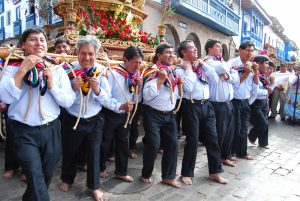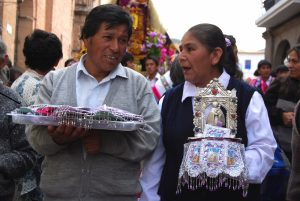Ritual, the Knot Creating Cities, Towns, and Fields

A mist cloaks the hills this morning and slowly lifts as the sun heats the Watanay valley. I am in Cusco, Peru, a land with much history, both real and un-real. Both are lived deeply.
When this was the capital of the Incas, an Andean-style city grew at the valley’s head. I say Andean city because, according to students of pre-Columbian urbanism, cities here were just different.
They were not places of residence, or centers of commerce. Instead, it is argued, they were ceremonial centers: bunches of temples, shrines, and ritual buildings. People did live in them, but their primary purpose was filled by people coming in for ritual, rather than making homes there or opening places of business.
People lived scattered on farmsteads throughout the Watanay valley and above. There they farmed and made lives, coming to the city as if it and its rituals where the lungs that made the society and economy work. Business was not the base of exchange and production. Ritual was, they say.
You can see some of this in contemporary rural towns. You have the town center and the surrounding countryside, with small villages and homestead scattered throughout. In Quechua the towns are called llaqta, and in Aymara marka. The point of both these words is that they are centers that represent all the surrounding land.

I have been in many Bolivian towns that are almost empty most days of the year. Sure a few people live there to take care of government, schools, and a few stores. Mostly, though, people live on their farms, though extended families and neighborhoods will have a house in town for when they have to be there for ritual or any of those other things.

When a feast day roles around, the town often fills as many of the people from the surrounding countryside flow in, a seasonal flood. They even make it overflow, not just with people but with energy, music, dance, song, and food: all the things of ritual
You can still see how important ritual is for making economies and government work, even though it has no category in official measures of political functioning or even less of the economy.
Hiding the power of ritual and the ways even now Andean towns, and perhaps cities, do not fit notions of civil society and of polities. They are like a rope twined from at least two cords. One is the Andean notion that is still found, even if blended with other ideas because of the five centuries that have elapsed since the conquest. The other is made from all the forms and ideas of the polities, societies, and economies that have developed since nineteenth and twentieth century feudalism was transformed.
The dual rope is strong and ties this world into a tight social knot.
However, the knot exists in what Taussig called an epistemic murk. He was referring to violence, but I think the notion has a lot to speak to society here.
Like a deep fog, the murk does not allow you to see clearly the organization and origins of each cord, nor the actual functioning of it. They are like objects that float in and out of sight, especially if you try to shine too much light on them with your bright beams.
Sometimes, the murk performs differently. You can see the object clearly, but it is supposed to be foggy, like a Cuzco morning before the sun burns everything off. There are just things people grow up learning to see and not see at the same time.
In a way, that is like Cuzco’s Inca past.

For example: the Christian shrines of Cuzco. Many of them involve crosses or images built on rocks, mountains, water sources, and so on that received devotion before. They actively occupy places that were significant to people before the Spanish came. Following a European custom, the Spanish did a double imposition which involves a combination of seeing and not-seeing, visibility and invisibility.
At Teteqaqa, you will see a big rock and an enormous rock, carefully carved and mobilized sometime in the past. You are supposed to see both and locate them in a Christian metanarrative which talks of Christ replacing pre-Christian ways. Even though it is relatively small and stands under a corrugated tin roof against the massive and complex rock, you are supposed to focus on the cross and make the rock background.
You can turn it around, however. That too is implied in the construction. You can see the rock first and reduce the cross to a commentary. All of that is presumed in the episteme, the organization of reality, of Spanish Christianity.





Christianity has had a custom of adopting existing religious symbols. Mithras’s birthday and the Saturnalia were turned into Christmas, Samhain became Hallowe’en, and the Jesuits tried to incorporate Chinese ancestor worship into the Christian cosmos. When Buddhism expanded into Tibet, much of the existing Bon religion was incorporated, thus creating Vajrayana Buddhism. Is this customary with expanding religions, I wonder? How much has Islam incorporated from the existing religions of the Near East, Subsaharan Africa, and Central Asia?